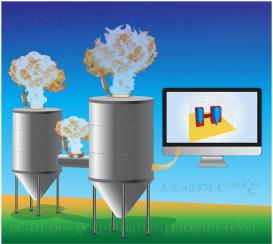Journal of Loss Prevention in the Process Industries ( IF 3.5 ) Pub Date : 2020-04-23 , DOI: 10.1016/j.jlp.2020.104149 Nicholas S. Reding , Mark B. Shiflett

|
Combustible dust explosions continue to present a significant threat toward operating personnel and pneumatic conveyance equipment in a wide variety of processing industries. Following ignition of suspended fuel within a primary enclosure volume, propagation of flame and pressure fronts toward upstream or downstream interconnected enclosures can result in devastating secondary explosions if not impeded through an appropriate isolation mechanism. In such occurrences, an accelerated flame front may result in flame jet ignition within the secondary vessel, greatly increasing the overall explosion severity. Unlike an isolated deflagration event with quantifiable reduced pressures (vent sizing according to NFPA 68 guidance), oscillation of pressure between primary and secondary process vessels leads to uncertain overpressure effects. Dependent on details of the application such as relative enclosure volumes, relief area, fuel type, suspended concentration, duct size, and duct length, the maximum system pressure in both interconnected vessels can be unpredictable. This study proposes the use of FLame ACceleration Simulator (FLACS) computational fluid dynamics (CFD) modeling to provide reliable consequence predictions for specific case scenarios of dust deflagrations involving interconnected equipment. Required minimum supplement to the originally calculated relief area (Av) was determined through iterative simulation, allowing for reduced explosion pressures (Pred) to be maintained below theoretical enclosure design strengths (Pes).
中文翻译:

使用计算流体动力学模型预测涉及互连容器的粉尘爆炸的后果
可燃粉尘爆炸继续对各种加工行业的操作人员和气动输送设备构成重大威胁。在主外壳空间内点燃悬浮燃料后,如果不通过适当的隔离机制阻止,火焰和压力前沿向上游或下游互连外壳的传播会导致毁灭性的二次爆炸。在这种情况下,加速的火焰锋可能导致辅助容器内的火焰喷射点火,从而大大增加了整体爆炸的严重性。与单独的爆燃事件具有可量化的减压(根据NFPA 68指南确定排气口大小)不同,一次和二次处理容器之间的压力波动会导致不确定的超压影响。取决于应用程序的详细信息,例如相对外壳体积,泄压面积,燃料类型,悬浮浓度,管道尺寸和管道长度,两个互连容器中的最大系统压力可能无法预测。这项研究建议使用火焰加速仿真器(FLACS)计算流体动力学(CFD)建模为涉及互连设备的粉尘爆燃的特定情况提供可靠的结果预测。最初计算的救济区域所需的最小补充量(A 这项研究建议使用火焰加速仿真器(FLACS)计算流体动力学(CFD)建模为涉及互连设备的粉尘爆燃的特定情况提供可靠的结果预测。最初计算的救济区域所需的最小补充量(A 这项研究建议使用火焰加速仿真器(FLACS)计算流体动力学(CFD)建模为涉及互连设备的粉尘爆燃的特定情况提供可靠的结果预测。最初计算的救济区域所需的最小补充量(Av)是通过迭代模拟确定的,可以将降低的爆炸压力(P red)保持在理论外壳设计强度(P es)以下。

























 京公网安备 11010802027423号
京公网安备 11010802027423号